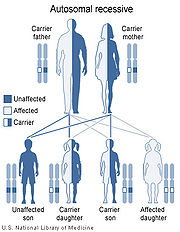
Dihydropyrimidine dehydrogenase deficiency
Encyclopedia
Dihydropyrimidine dehydrogenase deficiency (DPD deficiency) is an autosomal
recessive
metabolic disorder in which there is absent or significantly decreased activity of dihydropyrimidine dehydrogenase
, an enzyme involved in the metabolism of uracil
and thymine
.
Individuals with this condition may develop life-threatening toxicity following exposure to 5-fluorouracil (5-FU), a chemotherapy drug that is used in the treatment of cancer. Beside 5-FU, widely prescribed oral fluoropyrimidine capecitabine (Xeloda) could put DPD-deficient patients at risk of experiencing severe or lethal toxicities as well.

DPD deficiency is inherited in an autosomal recessive manner. This means the defective gene responsible for the disorder is located on an autosome
, and two copies of the defective gene (one inherited from each parent) are required in order to be born with the disorder. The parents of an individual with an autosomal recessive disorder both carry
one copy of the defective gene, but usually do not experience any signs or symptoms of the disorder.
It is more common among African-Americans than it is among Caucasian
s.
Autosome
An autosome is a chromosome that is not a sex chromosome, or allosome; that is to say, there is an equal number of copies of the chromosome in males and females. For example, in humans, there are 22 pairs of autosomes. In addition to autosomes, there are sex chromosomes, to be specific: X and Y...
recessive
metabolic disorder in which there is absent or significantly decreased activity of dihydropyrimidine dehydrogenase
Dihydropyrimidine dehydrogenase
Dihydropyrimidine dehydrogenase is an enzyme that is involved in pyrimidine degradation. It is the initial and rate-limiting step in pyrimidine catabolism. It catalyzes the reduction of uracil and thymine. It is also involved in the degradation of the chemotherapeutic drugs 5-fluorouracil and...
, an enzyme involved in the metabolism of uracil
Uracil
Uracil is one of the four nucleobases in the nucleic acid of RNA that are represented by the letters A, G, C and U. The others are adenine, cytosine, and guanine. In RNA, uracil binds to adenine via two hydrogen bonds. In DNA, the uracil nucleobase is replaced by thymine.Uracil is a common and...
and thymine
Thymine
Thymine is one of the four nucleobases in the nucleic acid of DNA that are represented by the letters G–C–A–T. The others are adenine, guanine, and cytosine. Thymine is also known as 5-methyluracil, a pyrimidine nucleobase. As the name suggests, thymine may be derived by methylation of uracil at...
.
Individuals with this condition may develop life-threatening toxicity following exposure to 5-fluorouracil (5-FU), a chemotherapy drug that is used in the treatment of cancer. Beside 5-FU, widely prescribed oral fluoropyrimidine capecitabine (Xeloda) could put DPD-deficient patients at risk of experiencing severe or lethal toxicities as well.
Genetics

DPD deficiency is inherited in an autosomal recessive manner. This means the defective gene responsible for the disorder is located on an autosome
Autosome
An autosome is a chromosome that is not a sex chromosome, or allosome; that is to say, there is an equal number of copies of the chromosome in males and females. For example, in humans, there are 22 pairs of autosomes. In addition to autosomes, there are sex chromosomes, to be specific: X and Y...
, and two copies of the defective gene (one inherited from each parent) are required in order to be born with the disorder. The parents of an individual with an autosomal recessive disorder both carry
Genetic carrier
A genetic carrier , is a person or other organism that has inherited a genetic trait or mutation, but who does not display that trait or show symptoms of the disease. They are, however, able to pass the gene onto their offspring, who may then express the gene...
one copy of the defective gene, but usually do not experience any signs or symptoms of the disorder.
Epidemiology
Current research suggests that nearly 8% of the population has at least partial DPD deficiency. A diagnostics determination test for DPD deficiency is available and it is expected that with a potential 500,000 people in North America using 5-FU this form of testing will increase. The whole genetic events affecting the DPYD gene and possibly impacting on its function are far from being elucidated, and epigenetic regulations could probably play a major role in DPD deficiency.It is more common among African-Americans than it is among Caucasian
Caucasian race
The term Caucasian race has been used to denote the general physical type of some or all of the populations of Europe, North Africa, the Horn of Africa, Western Asia , Central Asia and South Asia...
s.

